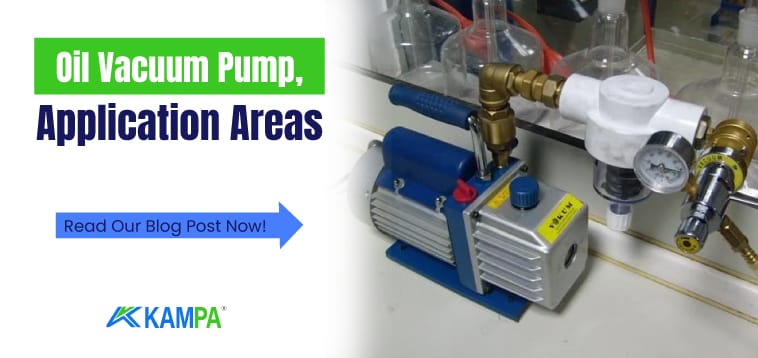Oil Vacuum Pump, Application Areas
An oil vacuum pump is a device that transports gases or vapors from one place to another by creating a pressure difference. Oil vacuum pumps work with a system in which oil acts as sealing and cooling.
Table of Contents
The areas of use of oil vacuum pumps are quite wide. For example, oily vacuum pumps are needed in sectors such as chemistry, pharmaceuticals, food, plastics, textiles, metallurgy, electronics and automotive.
How does an oil vacuum pump work?
Oil vacuum pumps are devices that transport gases or vapors from one place to another by creating a pressure difference. Oil vacuum pumps work with a system in which oil acts as sealing and cooling. So how do oil vacuum pumps work? Here is how oily vacuum pumps work:
- The oil vacuum pump consists of a rotor rotating on a shaft driven by an electric motor. Above the rotor are two pallets supported by springs. The pallets move in a cylindrical body as the rotor rotates.
- At the inlet of the cylindrical body, gas or vapor is sucked in. The sucked gas or vapor is compressed between the volumes formed by the pallets. The compressed gas or vapor moves towards the outlet of the cylindrical body.
- At the outlet of the cylindrical body, there is an oil injector. The oil injector sprays oil at high pressure. The sprayed oil mixes with gas or vapor, cooling and sealing them. Furthermore, the oil prevents wear of the pallets and the cylindrical body.
- The mixed oil and gas or vapor are removed from the cylindrical body. The extracted mixture is sent to a separator. In the separator, oil and gas or vapor are separated. The separated oil is cleaned with a filter and reused. The separated gas or vapor is transported to the desired location.
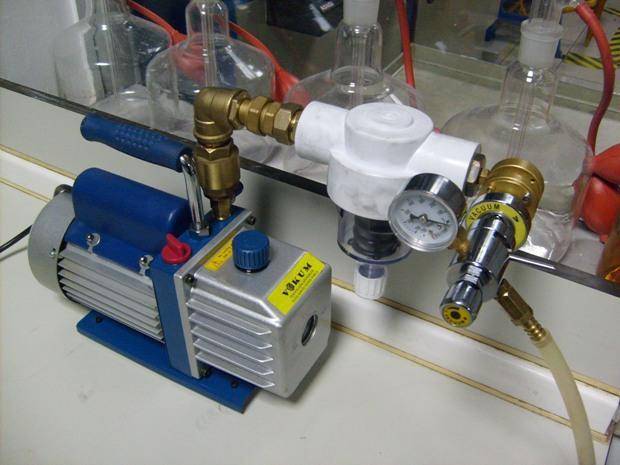
What are the advantages of an oil vacuum pump?
The most important advantage of oil vacuum pumps is that they can reach high vacuum levels. Oil vacuum pumps can reach pressure values as low as 0.1 mbar. This makes them ideal for precision and quality processes.
In addition, oil vacuum pumps operate more quietly and without vibration than dry vacuum pumps. Oil vacuum pumps are more resistant to wear and corrosion thanks to the protective effect of the oil.
Oil vacuum pumps require simple and easy maintenance. Long-lasting performance can be achieved with oil change and filter cleaning.
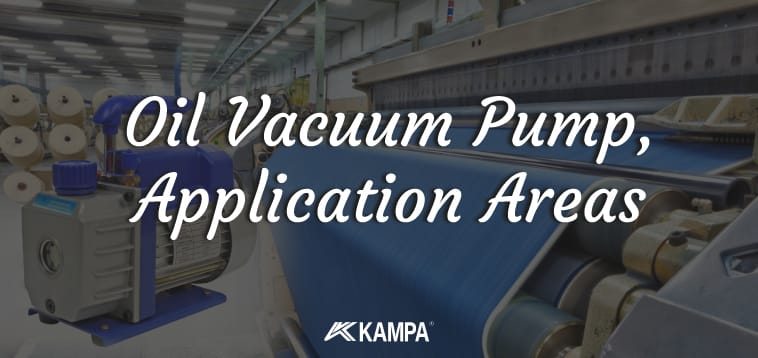
What are the disadvantages of an oil vacuum pump?
The biggest disadvantage of oil vacuum pumps is their oil consumption. Oil vacuum pumps have to constantly renew the oil during operation. This increases operating costs.
Furthermore, oil lubricated vacuum pumps pose a risk of environmental pollution. If oil mixes with gas or vapor, harmful emissions can occur. This is dangerous for both human health and natural resources.
Oil vacuum pumps also cannot be used in some applications where oil is incompatible. For example, oil vacuum pumps should not be used with flammable gases such as oxygen or in humid environments.
Why use oil?
Oil vacuum pumps are devices that transport gases or vapors from one place to another by creating a pressure difference. Oil vacuum pumps work with a system in which oil acts as sealing and cooling. So why use oil? Here is the importance of oil in oil vacuum pumps:
- It mixes with oil, gas or vapor and cools them. This prevents the vacuum pump from heating up and reducing its efficiency. Also, the cooled gas or vapor can be transported more easily.
- Provides sealing by mixing with oil, gas or vapor. This maintains the pressure differential inside the vacuum pump. Furthermore, the sealing prevents gas or vapor from escaping or air from entering from outside.
- The oil prevents wear of the paddles and the cylindrical body. This extends the life of the vacuum pump. Furthermore, the anti-wear oil reduces the need for maintenance of the vacuum pump.
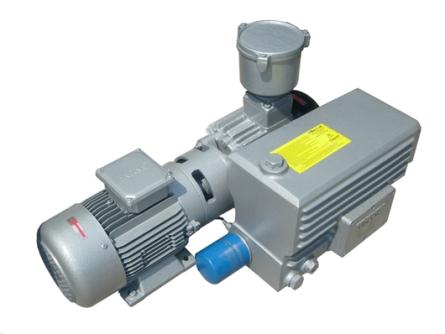
What is the working principle of oil vacuum pumps?
The working principle of oil vacuum pumps is as follows:
- The oil vacuum pump consists of a rotor rotating on a shaft driven by an electric motor. Above the rotor are two pallets supported by springs. The pallets move in a cylindrical body as the rotor rotates.
- At the inlet of the cylindrical body, gas or vapor is sucked in. The sucked gas or vapor is compressed between the volumes formed by the pallets. The compressed gas or vapor moves towards the outlet of the cylindrical body.
- At the outlet of the cylindrical body, there is an oil injector. The oil injector sprays oil at high pressure. The sprayed oil mixes with gas or vapor, cooling and sealing them. Furthermore, the oil prevents wear of the pallets and the cylindrical body.
- The mixed oil and gas or vapor are removed from the cylindrical body. The extracted mixture is sent to a separator. In the separator, oil and gas or vapor are separated. The separated oil is cleaned with a filter and reused. The separated gas or vapor is transported to the desired location.
How durable are oil vacuum pumps?
Oil vacuum pumps are devices that transport gases or vapors from one place to another by creating a pressure difference. Oil vacuum pumps work with a system in which oil acts as sealing and cooling. So, how durable are oil vacuum pumps? Here is information about the durability of oil vacuum pumps:
- Oil lubricated vacuum pumps are more resistant to wear and corrosion thanks to the protective effect of the oil. The oil reduces the friction of the paddles and the cylindrical body, preventing them from wearing out. Furthermore, the oil mixes with gas or vapor, cooling and sealing them. This maintains the pressure differential inside the vacuum pump and protects it against external influences.
- Oil vacuum pumps require simple and easy maintenance. Long-lasting performance can be achieved with oil change and filter cleaning. Oil change depends on the operating time of the vacuum pump and the quality of the oil used. Generally, an oil change between 500 and 1000 hours is sufficient. Filter cleaning depends on the pollution level of the environment. Generally, between 100 and 200 hours of filter cleaning is sufficient.
- Oil vacuum pumps are more durable if they are selected in accordance with the working environment. The characteristics of the working environment such as temperature, humidity and pressure affect the performance and lifetime of the vacuum pump. Therefore, it is important to choose a vacuum pump suitable for the working environment. For example, for a vacuum pump that will operate at high temperature, it is necessary to use a high viscosity oil.
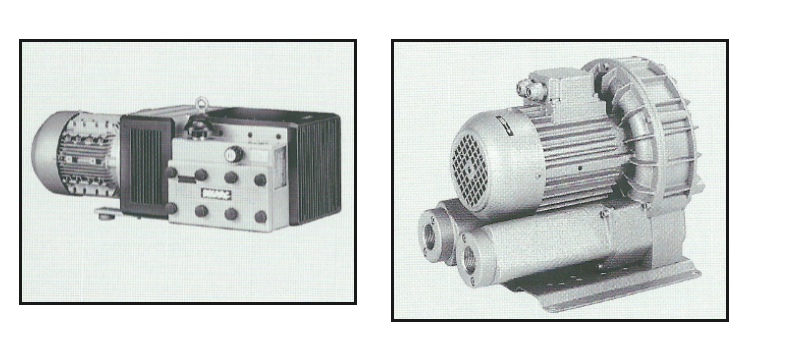
Are there different types?
Oil vacuum pumps are devices that transport gases or vapors from one place to another by creating a pressure difference. Oil vacuum pumps work with a system in which oil acts as sealing and cooling. But are there different types? Here are the different types of oil vacuum pumps:
- Single stage oil vacuum pumps: This type of vacuum pump consists of a single rotor and paddle. Single stage oil vacuum pumps have a simple and economical construction. However, they can reach low vacuum levels. Usually, they provide a vacuum level between 1 and 10 mbar.
- Double stage oil lubricated vacuum pumps: This type of vacuum pump consists of two rotors and paddles. Double-stage oil-oil vacuum pumps have a more complex and expensive construction. However, they can achieve high vacuum levels. Usually, they provide a vacuum level between 0.01 and 0.1 mbar.
How should we choose an oil vacuum pump?
There are some criteria we should pay attention to when choosing oil vacuum pumps. These are as follows:
- Vacuum level: We must determine the lowest pressure value required by our process. The lower the vacuum level, the more powerful the oil vacuum pump should be.
- Flow rate: We must determine the amount of gas or vapor our process requires. The higher the flow rate, the bigger the oil vacuum pump should be.
- Working environment: We must determine the characteristics of the environment in which our operation will take place, such as temperature, humidity, pressure. The more demanding the working environment, the more durable the oil vacuum pump should be.
- Compatibility: We must determine the type and properties of the gas or vapor we will use in our process. The more important compatibility is, the more selective the oil vacuum pump must be.
You can contact us for more information about the usage areas of oil vacuum pumps. We will be pleased to offer you the most suitable oil vacuum pump prices.

